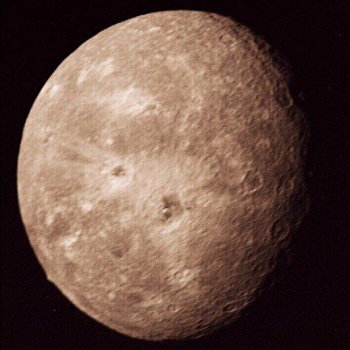Oberon

Oberon, imaged by Voyager 2 on 24 January 1986, from a distance of 660,000 kilometers.
Oberon is the second largest moon of Uranus and the 18th in order from the planet. Oberon was discovered by William Herschel on 11 January 1787. It is named after the king of the Fairies in Shakespeare's A Midsummer Night's Dream and is also known as Uranus IV.
Oberon's heavily cratered surface, featuring far more and larger craters than do Ariel or Titania, is clearly ancient. Some of the craters have bright rays similar to those seen on Jupiter's moon Callisto and some of the crater floors are dark – covered perhaps with a mixture of carbonaceous substances and ice that erupted from below. Large faults run across the entire southern hemisphere, indicating geologic activity in Oberon's youth. In the image shown here, note the large mountain, about 6 kilometers high, that stands out on the lower left limb.
| discovery | 1787, by William Herschel |
| semimajor axis | 582,600 km (361,860 mi) |
| diameter | 1,523 km (947 mi) |
| mean density | 1.64 g/cm3 |
| escape velocity | 0.729 km/s (2,624 km/h, 1,631 mph) |
| orbital period | 13.463 days (13 d 11 hr) |
| orbital eccentricity | 0.0008 |
| orbital inclination | 0.10º |
| axial period | 13.463 days |
| visual albedo | 0.24 |


